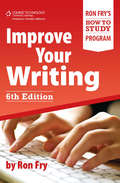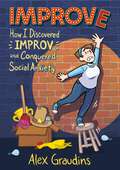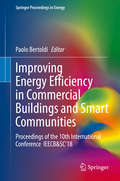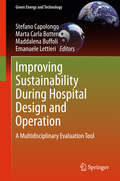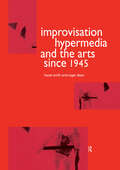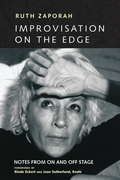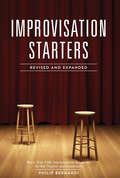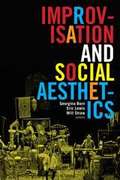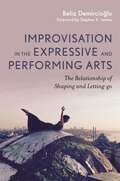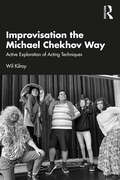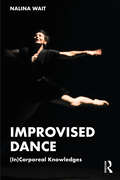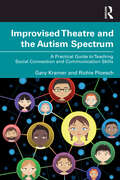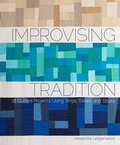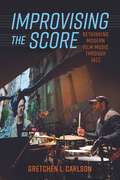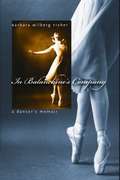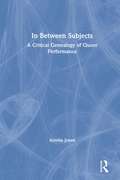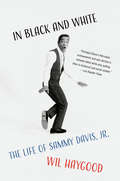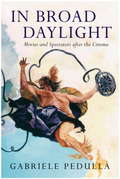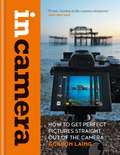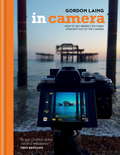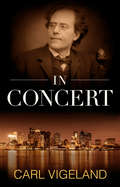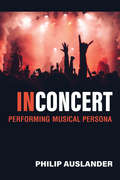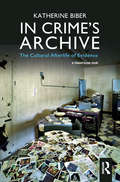- Table View
- List View
Improve Your Writing
by Ron FryFrom selecting a topic and conducting research to developing an outline, writing drafts, proofreading, and more, Improve Your Writing takes you step-by-step through the creation of a successful research paper. Applicable to any kind of writing addressing any subject matter, author Ron Fry's fundamental and systematic approach goes beyond one size fits all checklists to offer real advice that can be adapted according to your individual needs and situations. Ideal for anyone hoping to establish essential research, organization, and writing skills, the text empowers you to excel in school, on essay tests, and in life.
Improve: How I Discovered Improv and Conquered Social Anxiety
by Alex GraudinsA graphic memoir for teens about the author's efforts to overcome her social anxiety by learning improv comedy.Alex has crippling social anxiety. All day long, she is trapped in a web of negative thoughts and paralyzing fear. To pull herself free of this endless cycle, Alex does something truly terrifying: she signs up for an improv comedy class. By forcing herself to play silly games and act out ridiculous scenes, Alex confronts the unbearable weight of embarrassment, makes new friends, rediscovers parts of herself that she'd hidden away, and ultimately faces her greatest fear by performing onstage for all to see.
Improving Energy Efficiency in Commercial Buildings and Smart Communities: Proceedings of the 10th International Conference IEECB&SC’18 (Springer Proceedings in Energy)
by Paolo BertoldiThese proceedings present fourteen peer-reviewed papers from the 10th International Conference on Improving Energy Efficiency in Commercial Buildings and Smart Communities, which was held March 21-22, 2018 in Frankfurt, Germany. This biannual conference aims to promote and diffuse the concept of energy efficiency in new and existing commercial buildings and to enlarge the market for low consumption and sustainable non-residential buildings. It also covers smart and sustainable districts, communities and cities, since energy systems efficiency and renewable energies are often optimized at the district or municipal level. The 2018 conference focused on advanced and innovative technologies to improve the energy efficiency of commercial buildings, communities and cities as well as the policies and measures by governments at various levels to improve energy efficiency. A particular focus was on Energy Service Companies (ESCOs). The conference addresses energy policy makers at international, national, and local level; academics, researchers and energy efficiency experts; ESCOs, utilities, buildings energy and environmental managers; buildings engineers and architects; and equipment manufacturers and commercial property investors.
Improving Sustainability During Hospital Design and Operation
by Stefano Capolongo Marta Carla Bottero Maddalena Buffoli Emanuele LettieriThis book describes the Sustainable High Quality Healthcare (SustHealth) project, which had the goal of developing an original multidisciplinary evaluation tool that can be applied to assess and improve hospitals' overall sustainability. The comprehensive nature of the appraisal offered by this tool exceeds the scope of most current rating systems, which typically permit a thorough evaluation of relevant environmental factors when designing a new building but fail to consider social and economic impacts of the design phase or the performance of the hospital's operational structure in these fields. The multidisciplinary evaluation system was developed, from its very inception through to its testing, by following a scientific experimental method in which a global perspective was constantly maintained, as opposed to a focus only on specific technical issues. Application of the SustHealth rating tool to a currently functioning hospital, or one under design, will identify weaknesses and guide users to potential low-cost short-term solutions and longer-term strategies for improvement.
Improvisation Hypermedia and the Arts since 1945 (Performing Arts Studies #Vol. 4)
by Hazel Smith Roger DeanFirst Published in 1997. The authors’ purpose in this book is to dissect developments in improvisation in the arts since 1945, with a particular emphasis on process and technique. The approach is analytical and theoretical but is also relevant to practitioners and their audience. Their key argument is that improvisation has been of great importance and value in the contemporary arts, particularly because of its potential to develop new forms (often by breaking definitions).
Improvisation On the Edge
by Rinde Eckert Joan Sunderland Ruth ZaporahDirected not only toward actors, dancers, and other performing artists who draw upon improvisation as part of their craft, this Zen-infused memoir of a life lived creatively will pique the interest of anyone in search of liberation from self-limiting concepts. What does it mean to live in a body? What does it mean to improvise? Do we wonder whether we're capable of improvising--to make up things as we go, step into the unknown, take a risk that changes our notion of ourselves and the world? Author Ruth Zaporah has been a professional physical theater performer, writer, director, and teacher for forty years. Early on she realized that with a shift of perception, every moment of an improvisation holds both the familiar and the utterly new. With the same shift, so does every moment of life; every moment holds both the known and the unknown. And, as Zaporah says, "The body leads the way in this book. In each chapter the world is experienced by it and of it. It is the body that adds richness, wildness, and grace. The body invokes images and feelings. It is the body that imagines." Improvisation on the Edge recounts events from Zaporah's life such as improvisational shows in the war zones of Sarajevo and Kosovo; apprenticing with a Huichol medicine woman from Chiapas, Mexico; understanding the concept of "practice" while on a beach; a bus ride in Cuba; a car ride in Estonia; the intricacies of onstage collaborations. Interspersed are chapters about awareness, listening, adapting, resiliency, time, space, silence, simplicity--all within the context of everyday life in the body. In several other chapters, Ruth writes from the logical (and nonlinear) voice of the improviser as she is on stage, within the immediate embodied process. A fascinating glimpse into the mind of an artist and true master of improvisation, this book will appeal to performers, teachers, and anyone who has ever needed to "wing it" with confidence and grace. Table of Contents 1. Something That Needs Listening To 2. Mirror Mirror 3. On My Wall 4. Tutu Solitude 5. A Mind in Three Episodes 6. A Splish Splash Orchestra 7. A Take on Talk 8. Bobby's River 9. Roar 10. Meet Yourself Babe 11. Nuts and Bolts 12. Out of Chaos 13. Changing Course 14. The Flying Shaman 15. You Could Say Death 16. Ain't It The Truth 17. The Raging Boomerang 18. See This Feel That 19. Stalking War 20. Your Mother Just Died Christina, Leave the Backdoor Open 21. The Illusive Genture 22. A Pack of Lies 23. Again Gun and Boys 24. A Ride in Estonia 25. Art and Heart 26. Floating to the Surface 27. Stuffed With Junk 28. A Chair in Cuba 29. Any Where Practice 30 Teacher Says 31. Older and Under
Improvisation Starters Revised and Expanded Edition: More Than 1,000 Improvisation Scenarios for the Theater and Classroom
by Philip BernardiImprovisation is an essential and invaluable technique for the actor's repertoire: It asks you to think beyond a script - and its memorized lines, movements, and facial expressions - to deliver a performance filled with honesty, insight, nuance, and verisimilitude.Improvisation Starters Revised and Expanded provides more than 1,000 brand-new scenarios that will help you:Depict confl ict by focusing on differing beliefs, motivations, and needsUse contrasts to show the clash of personalities and emotionsCreatively incorporate props and specific lines of dialogue within an improvised sceneExplore character relationships with various locationsTake on the role of inanimate objects and animalsFrom the classroom to the community theater group - and even in business, language, and technology classes - improvisation is the perfect tool for thinking critically, communicating clearly, building self-confi dence, and developing interpersonal skills. With this revised edition of Improvisation Starters, you’ll bring new vitality to the stage or set - and have fun in the process!
Improvisation and Social Aesthetics
by Will Straw Georgina Born Eric LewisAddressing a wide range of improvised art and music forms—from jazz and cinema to dance and literature—this volume's contributors locate improvisation as a key site of mediation between the social and the aesthetic. As a catalyst for social experiment and political practice, improvisation aids in the creation, contestation, and codification of social realities and identities. Among other topics, the contributors discuss the social aesthetics of the Association for the Advancement of Creative Musicians, the Feminist Improvising Group, and contemporary Malian music, as well as the virtual sociality of interactive computer music, the significance of "uncreative" improvisation, responses to French New Wave cinema, and the work of figures ranging from bell hooks and Billy Strayhorn to Kenneth Goldsmith. Across its diverse chapters, Improvisation and Social Aesthetics argues that ensemble improvisation is not inherently egalitarian or emancipatory, but offers a potential site for the cultivation of new forms of social relations. It sets out a new conceptualization of the aesthetic as immanently social and political, proposing a new paradigm of improvisation studies that will have reverberations throughout the humanities.Contributors. Lisa Barg, Georgina Born, David Brackett, Nicholas Cook, Marion Froger, Susan Kozel, Eric Lewis, George E. Lewis, Ingrid Monson, Tracey Nicholls, Winfried Siemerling, Will Straw, Zoë Svendsen, Darren Wershler
Improvisation in the Expressive and Performing Arts: eBook
by Stephen K. Levine Beliz DemirciogluThis book explores the process of improvisation and outlines the ideal conditions for an inspirational creative state. Examining her own process as an artist and drawing on interviews with peers, the author considers how the forces of shaping (intellect-driven decisions) and letting-go (more intuitive moves) interact in improvisation.The book follows the journey of seven performing arts graduates and undergraduates, examining their experiences of improvisation and the interplay of shaping and letting-go. It reveals how the approach and methods of expressive arts can enrich an improviser's experience and spur the desire for discovery.
Improvisation the Michael Chekhov Way: Active Exploration of Acting Techniques
by Wil KilroyImprovisation the Michael Chekhov Way: Active Exploration of Acting Techniques provides readers with dozens of improvisational exercises based on the acting techniques of Michael Chekhov. The book features key exercises that will help the actor explore improvisation and expand their imagination through the technique. Exercises that have been successfully taught for decades via the intensive trainings from the National Michael Chekhov Association are now clearly laid out in this book, along with information on how these performance-based techniques can be applied to a script and even provide life benefits. Guidance on how to use the exercises both in a group setting and as an individual is provided, as well as tools for lesson plans for up to a year of actor training. These step-by-step exercises will allow readers to expand their range of expression, discover the joy of creating unique characters, improve stage presence and presentation skills, and find new, creative ways to look at life. Improvisation the Michael Chekhov Way is written to be used by individual actors and practitioners and in group settings such as acting or improvisation courses, and to benefit anyone wishing to enhance their creativity and imagination.
Improvised Dance: (In)Corporeal Knowledges
by Nalina WaitThis book elucidates the technical aspects of improvised dance performance and reframes the notion of labour in the practice from one that is either based on compositionally formal logic or a mysterious impulse, to one that addresses the (in)corporeal dimensions of practice. Mobilising the languages and conceptual frameworks of theories of affect, embodied cognition, somatics, and dance, this book illustrates the work of specialist improvisers who occupy divergent positions within the complex field of improvised dance. It offers an alternative narrative of the history and current practice of Western improvised dance centred on the epistemology of its (in)corporeal knowledges, which are elusive yet vital to the refinement of expertise. Written for both a disciplinary-specific and interdisciplinary audience, this book will interest dance scholars, students, and practising artists.
Improvised Theatre and the Autism Spectrum: A Practical Guide to Teaching Social Connection and Communication Skills
by Gary Kramer Richie PloeschThis guide provides educators, professionals, and parents with an easy-to-follow and comprehensive approach to utilizing improvised theatre as a tool to teach social and communication skills to individuals on the autism spectrum. Opening with the philosophy of the curriculum and the considerations of mental health, play, and environmental factors on individuals with autism, the book then breaks down specific activities, suggests course sequencing, and explains how each activity works and applies to desired outcomes. Packed with dozens of activities and explanations, the book includes all the information necessary to design a full curriculum or create an at-home learning program for parents. By combining the fun and engaging atmosphere of improvisational theatre with the systematic teaching of social skills, professionals and parents can cultivate learning in a way that keeps students engaged while providing long-lasting improvements in social interaction, self-confidence, and communication.
Improvising Tradition: 18 Quilted Projects Using Strips, Slices, and Strata
by Alexandra LedgerwoodImprovisational piecing methods anchored within traditional quilting designs. Improvising Tradition pairs improvisationally pieced elements with more structured, and perhaps more familiar, quilt patterns to create projects that share a fresh, clean, and modern aesthetic. Author Alexandra Ledgerwood introduces readers to three basic improv piecing techniques: strip sets, piecing improvised strata, and slice and insert, then marries them with traditional quilting designs such as log cabins, coin and bar quilts, and even Hawaiian quilts. By using improvised elements within traditional patchwork quilt designs, Alexandra merges new and old quilting styles into projects that will appeal to a wide range of quilters. Eighteen original and modern quilting projects combine the beauty and familiarity of traditional techniques with the fresh, fun spirit of improvised quilting.
Improvising the Score: Rethinking Modern Film Music through Jazz
by Gretchen L. Carlson2023 Jazz Journalists Association (JJA) Jazz Awards for Books of the Year—Honorable Mention RecipientOn December 4, 1957, Miles Davis revolutionized film soundtrack production, improvising the score for Louis Malle’s Ascenseur pour l’échafaud. A cinematic harbinger of the French New Wave, Ascenseur challenged mainstream filmmaking conventions, emphasizing experimentation and creative collaboration. It was in this environment during the late 1950s to 1960s, a brief “golden age” for jazz in film, that many independent filmmakers valued improvisational techniques, featuring soundtracks from such seminal figures as John Lewis, Thelonious Monk, and Duke Ellington. But what of jazz in film today? Improvising the Score: Rethinking Modern Film Music through Jazz provides an original, vivid investigation of innovative collaborations between renowned contemporary jazz artists and prominent independent filmmakers. The book explores how these integrative jazz-film productions challenge us to rethink the possibilities of cinematic music production. In-depth case studies include collaborations between Terence Blanchard and Spike Lee (Malcolm X, When the Levees Broke), Dick Hyman and Woody Allen (Hannah and Her Sisters), Antonio Sánchez and Alejandro González Iñárritu (Birdman), and Mark Isham and Alan Rudolph (Afterglow). The first book of its kind, this study examines jazz artists’ work in film from a sociological perspective, offering rich, behind-the-scenes analyses of their unique collaborative relationships with filmmakers. It investigates how jazz artists negotiate their own “creative labor,” examining the tensions between improvisation and the conventionally highly regulated structures, hierarchies, and expectations of filmmaking. Grounded in personal interviews and detailed film production analysis, Improvising the Score illustrates the dynamic possibilities of integrative artistic collaborations between jazz, film, and other contemporary media, exemplifying its ripeness for shaping and invigorating twenty-first-century arts, media, and culture.
Impure Acts: The Practical Politics of Cultural Studies
by Henry A. GirouxHenry A. Giroux challenges the contemporary politics of cynicism by addressing a number of issues including the various attacks on cultural politics, the multicultural discourses of academia, the corporate attack on higher education, and the cultural politics of the Disney empire.
In Balanchine’s Company
by Barbara FisherDuring her twelve years with Ballet Society and the New York City Ballet, Barbara Milberg worked under the direction of George Balanchine. She rose from corps de ballet to soloist, danced leading roles in Swan Lake and Illuminations, and performed in celebrated world premieres. In this observant and poignant memoir, she shares her recollections of Balanchine, his craft and his values, and lends insight into surprising aspects of his personality. Fisher gives readers a rare glimpse inside Balanchine's artistry, including vivid accounts of the makings of such important ballets as Schoenberg's Opus 34, AGON, and the world-famous Nutcracker. Told through the eyes of a young dancer in what seemed a truly magical place and time, In Balanchine's Company is ideal for ballet fans young and old. Rich in anecdote, insight, and humor, it offers a unique perspective on one of the twentieth century's cultural giants. Ebook Edition Note: All illustrations have been redacted.
In Between Subjects: A Critical Genealogy of Queer Performance
by Amelia JonesThis volume is a study of the connected ideas of "queer" and "gender performance" or "performativity" over the past several decades, providing an ambitious history and crucial examination of these concepts while questioning their very bases. Addressing cultural forms from 1960s–70s sociology, performance art, and drag queen balls to more recent queer voguing performances by Pasifika and Māori people from New Zealand and pop culture television shows such as RuPaul’s Drag Race, the book traces how and why "queer" and "performativity" seem to belong together in so many discussions around identity, popular modes of gender display, and performance art. Drawing on art history and performance studies but also on feminist, queer, and sexuality studies, and postcolonial, indigenous, and critical race theoretical frameworks, it seeks to denaturalize these assumptions by questioning the US-centrism and white-dominance of discourses around queer performance or performativity. The book’s narrative is deliberately recursive, itself articulated in order performatively to demonstrate the specific valence and social context of each concept as it emerged, but also the overlap and interrelation among the terms as they have come to co-constitute one another in popular culture and in performance and visual arts theory, history, and practice. Written from a hybrid art historical and performance studies point of view, this will be essential reading for all those interested in art, performance, and gender, as well as in queer and feminist theory.
In Black and White: The Life of Sammy Davis, Jr.
by Wil HaygoodHe was, for decades, one of the most recognizable figures in the cultural landscape, his image epitomizing a golden age of American show business. His career spanned a lifetime, but for years he has remained hidden behind the persona he so vigorously generated, and so fiercely protected. Now, in this surprising, illuminating, and compulsively readable biography, we are taken beyond the icon, into the extraordinary, singular life of Sammy Davis, Jr. In scrupulous detail and with stunning powers of evocation, Wil Haygood takes us back to the era of vaudeville, where it all began for four-year-old Sammy who ran out onstage one night and stole the show. From then on it was a motherless childhood on the road, singing and dancing his way across a segregated America with his father and the formidable showman Will Mastin, struggling together to survive the Depression and the demise of vaudeville itself. With an ambition honed by poverty and an obsessive need for applause, Sammy drove his way into the nightclub circuit of the 1940s and 1950s, when, his father and Mastin aging and out of style, he slowly began to make a name for himself, hustling his way to top billing and eventually to recording contracts. From there, he was to stake his claim on Broadway, in Hollywood, and, of course, in Las Vegas. Haygood brings Sammy's showbiz life into full relief against the backdrop of an America in the throes of racial change. Sammy grew up trapped between the worlds of blacks and whites, with so much invested in both. He made his living entertaining white people but was often denied service in the very venues he played. Drafted into a newly integrated U.S. Army in the 1940s, he saw up close the fierce tensions that seethed below the surface. Dragged into the civil rights movement, he witnessed a hatred that often erupted into violence. In his broad and varied friendships and alliances (with Frank Sinatra; Martin Luther King, Jr.; Richard Nixon; Sidney Poitier; Marilyn Monroe, to name just a few), not to mention his romances (his relationship with Kim Novak and his marriage to the blond beauty May Britt drew death threats), he forged uncharted paths across racial lines. Admired and reviled by both blacks and whites, he was tormented all his life by raging insecurities, and never quite came to terms with his own skin. Ultimately, his only true sense of his identity was as a performer.Based on painstaking research and more than 250 interviews, Wil Haygood brings us a sweeping and vivid cultural history of the twentieth century, chronicling black entertainment from its beginnings and the birth of popular culture as we know it. In Black and White transcends simple biography to become an important record, both celebratory and elegiacal, of a vanished America and its greatest entertainer.
In Broad Daylight
by Gabriele PedullaFrom plasma screens to smartphones, today moving images are everywhere. How have films adapted to this new environment? And how has the experience of the spectator changed because of this proliferation? In Broad Daylight investigates one of the decisive shifts in the history of Western aesthetics, exploring the metamorphosis of films in the age of individual media, when the public is increasingly free but also increasingly resistant to the emotive force of the pictures flashing around us. Moving deftly from philosophy of mind to film theory, from architectural practice to ethics, from Leon Battista Alberti to Orson Welles, Gabriele Pedullà examines the revolution that is reshaping the entire system of the arts and creativity in all its manifestations.
In Camera: How to Get Perfect Pictures Straight Out of the Camera
by Gordon LaingWith amazing low-light capabilities, incredible definition, intelligent autofocus and a host of other features, digital cameras have now become so powerful that they have left their users behind. Most photographers can take competent shots in a range of conditions, or fix imperfect exposures in Photoshop or Lightroom, but very few have the skill to push their cameras to the limit and capture the perfect shot, under all conditions, with no post-processing required.In Camera is the perfect way to take your photography to that level; to master your camera, understand light, exposure and composition, and make amazing photographs, whatever your camera, without cheating after the event. One hundred of Gordon's beautiful photos are given with his own expert commentary; full settings and camera details are included, and a host of tips and tricks let photographers of any level learn something from every example. The shots are taken with a wide range of cameras, and the emphasis is on getting results by improving your own skills, not wasting money on expensive equipment.
In Camera: Perfect Pictures Straight Out Of The Camera
by Gordon LaingWith amazing low-light capabilities, incredible definition, intelligent autofocus and a host of other features, digital cameras have now become so powerful that they have left their users behind. Most photographers can take competent shots in a range of conditions, or fix imperfect exposures in Photoshop or Lightroom, but very few have the skill to push their cameras to the limit and capture the perfect shot, under all conditions, with no post-processing required.In Camera is the perfect way to take your photography to that level; to master your camera, understand light, exposure and composition, and make amazing photographs, whatever your camera, without cheating after the event. One hundred of Gordon's beautiful photos are given his own expert commentary; full settings and camera details are included, and a host of tips and tricks let photographers of any level learn something from every example. The shots are taken with a wide range of cameras, and the emphasis is on getting results by improving your own skills, not wasting money on expensive equipment.
In Camera: Perfect Pictures Straight Out Of The Camera
by Gordon LaingWith amazing low-light capabilities, incredible definition, intelligent autofocus and a host of other features, digital cameras have now become so powerful that they have left their users behind. Most photographers can take competent shots in a range of conditions, or fix imperfect exposures in Photoshop or Lightroom, but very few have the skill to push their cameras to the limit and capture the perfect shot, under all conditions, with no post-processing required.In Camera is the perfect way to take your photography to that level; to master your camera, understand light, exposure and composition, and make amazing photographs, whatever your camera, without cheating after the event. One hundred of Gordon's beautiful photos are given with his own expert commentary; full settings and camera details are included, and a host of tips and tricks let photographers of any level learn something from every example. The shots are taken with a wide range of cameras, and the emphasis is on getting results by improving your own skills, not wasting money on expensive equipment.
In Concert
by Carl A. VigelandAn intimate, moving, dramatic story about the musicians in a great orchestra who make music come alive in performance and recording. The musicians here are members of the fabled Boston Symphony Orchestra, led by conductor Seiji Ozawa, during a season highlighted by Mahler's Second Symphony, The Resurrection.
In Concert: Performing Musical Persona
by Philip AuslanderThe conventional way of understanding what musicians do as performers is to treat them as producers of sound; some even argue that it is unnecessary to see musicians in performance as long as one can hear them. But musical performance, counters Philip Auslander, is also a social interaction between musicians and their audiences, appealing as much to the eye as to the ear. In Concert: Performing Musical Persona he addresses not only the visual means by which musicians engage their audiences through costume and physical gesture, but also spectacular aspects of performance such as light shows. Although musicians do not usually enact fictional characters on stage, they nevertheless present themselves to audiences in ways specific to the performance situation. Auslander’s term to denote the musician’s presence before the audience is musical persona. While presence of a musical persona may be most obvious within rock and pop music, the book’s analysis extends to classical music, jazz, blues, country, electronic music, laptop performance, and music made with experimental digital interfaces. The eclectic group of performers discussed include the Beatles, Miles Davis, Keith Urban, Lady Gaga, Nicki Minaj, Frank Zappa, B. B. King, Jefferson Airplane, Virgil Fox, Keith Jarrett, Glenn Gould, and Laurie Anderson.
In Crime's Archive: The Cultural Afterlife of Evidence
by Katherine BiberThis book investigates what happens to criminal evidence after the conclusion of legal proceedings. During the criminal trial, evidentiary material is tightly regulated; it is formally regarded as part of the court record, and subject to the rules of evidence and criminal procedure. However, these rules and procedures cannot govern or control this material after proceedings have ended. In its ‘afterlife’, criminal evidence continues to proliferate in cultural contexts. It might be photographic or video evidence, private diaries and correspondence, weapons, physical objects or forensic data, and it arouses the interest of journalists, scholars, curators, writers or artists. Building on a growing cultural interest in criminal archival materials, this book shows how in its afterlife, criminal evidence gives rise to new uses and interpretations, new concepts and questions, many of which are creative and transformative of crime and evidence, and some of which are transgressive, dangerous or insensitive. It takes the judicial principle of open justice – the assumption that justice must be seen to be done – and investigates instances in which we might see too much, too little or from a distorted angle. It centres upon a series of case studies, including those of Lindy Chamberlain and, more recently, Oscar Pistorius, in which criminal evidence has re-appeared outside of the criminal process. Traversing museums, libraries, galleries and other repositories, and drawing on extensive interviews with cultural practitioners and legal professionals, this book probes the legal, ethical, affective and aesthetic implications of the cultural afterlife of evidence.
